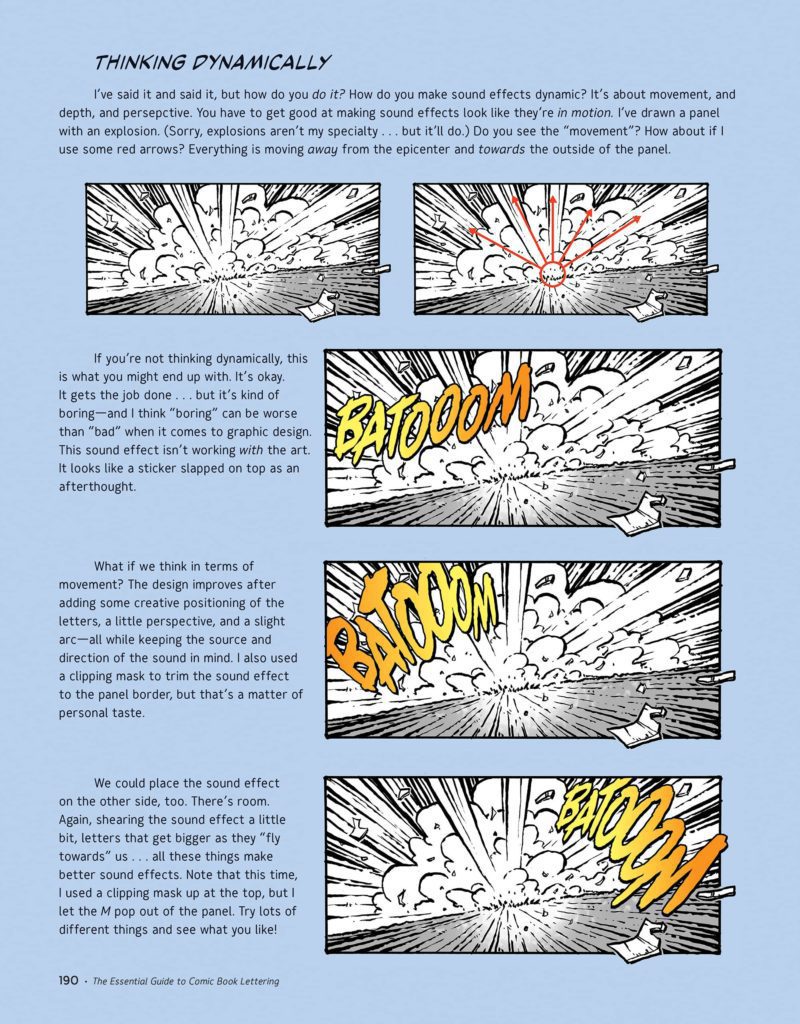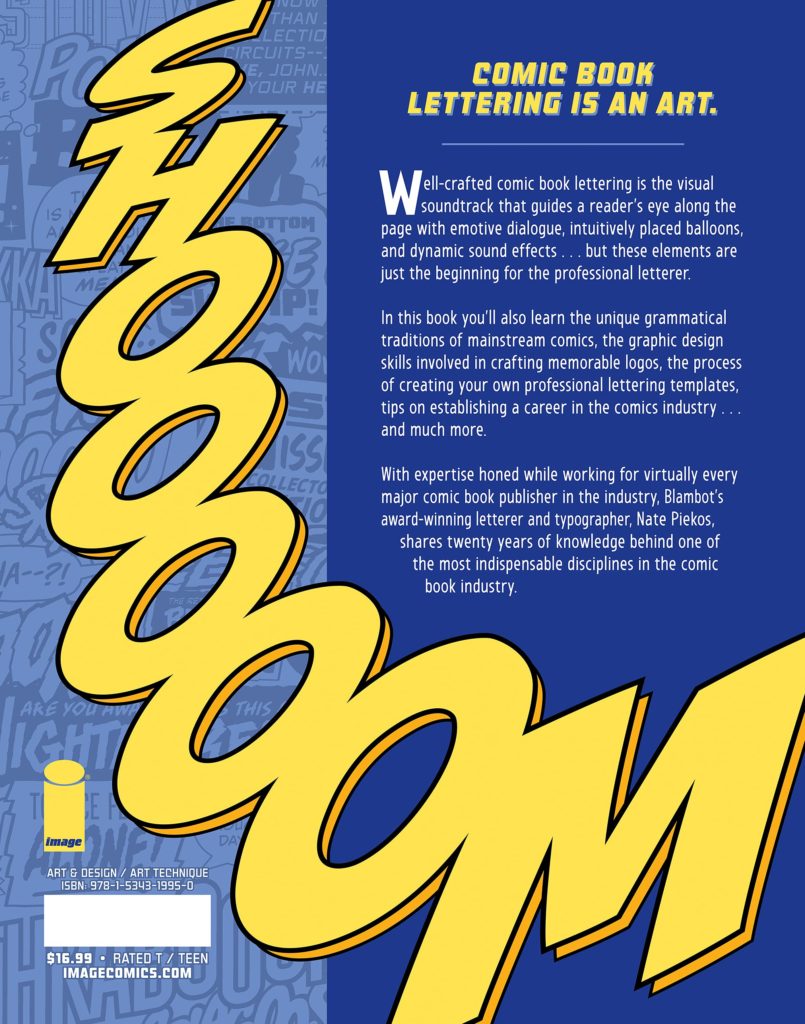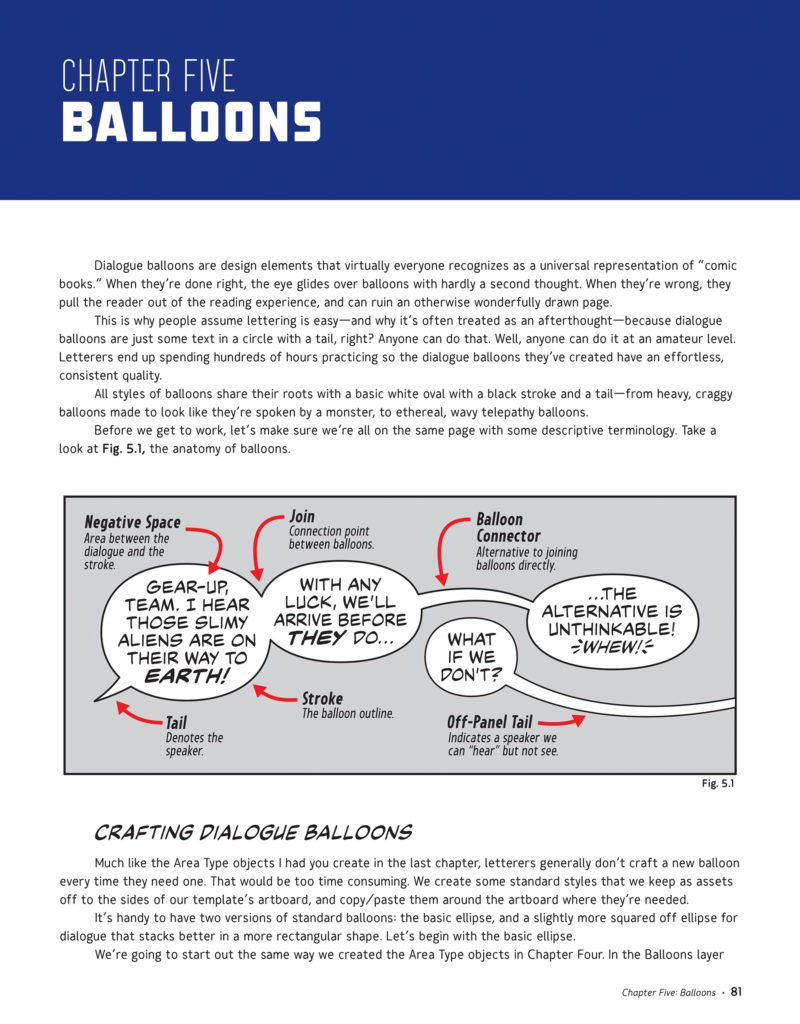For a number of years now, award winning comic book letterer Nate Piekos, founder of Blambot.com, has been posting lettering tips on various social media. He has also toyed with the idea of producing a book of these ideas, and this week The Essential Guide to Comic Book Lettering goes on general release. Published through Image Comics, the book is a detailed guide to the process of lettering in the comic book industry and is packed with guides, tips, and anecdotal commentary from the creator himself.
The Comic Book industry has changed massively over the last 100 hundred years. Creator rights and recognition are elements that have seen a dramatic shift from barely getting a mention in the early comics of the 1930s and 1940s to becoming major selling points of some titles. Relaunches of famous characters, such as Batman or Spider-Man, have been built around the creative team, especially the writer or artist, and this has led to some creators becoming almost household names. However, there are still elements of the industry that are less known; production elements that many readers and critics take for granted. Elements such as Coloring and Lettering.
A few years ago, the appreciation of comic book coloring began to grow thanks to advocates such as Jordie Bellaire, Matt Wilson, and Laura Allred. And now, letterers are beginning to get more recognition because of the promotional drives from creators like Hassan Otsmane-Elhaou and Nate Piekos.
MFR ON YOUTUBE (latest video)
Help us reach 5K Subs!

The Format
To some, lettering is seen as simply copying and pasting from a script, and to others it is a mystical art; unexplainable witchcraft. The truth, as The Essential Guide to Comic Book Lettering proves, is somewhere in between: it is a highly technical skill, but one that is attainable. Piekos breaks the process down across the 256 pages and walks the reader, and potential future letterer, through each step in highly detailed yet easy to follow instructions. He takes every aspect of the craft, from setting up the studio and equipment to delivering the final product to the publisher, and explains everything you could possibly need to know; step by step; process by process. This book is a highly detailed instruction manual for the budding letterer.
Piekos opens with an introduction about himself and why the book exists in the first place. He makes it clear from the start what he hopes to achieve and, without doubt, he hits the mark. This is a comprehensive instruction manual full of facts, guides, and useful tips for creating the best comic book lettering possible. It is acknowledged that a certain level of creativity is required but the learning process is mentioned again and again. Practice makes perfect is one of the themes running throughout the chapters and an encouragement for experimentation is one of Piekos’ strongest recommendations. This book gives future letterers the tools and knowledge to work in the industry but it is also an encouraging read. You get the impression that Piekos is on your side, an enthusiastic teacher plying you with as much knowledge as possible. The bonus is that it’s all there, on paper, ready to be flicked through over and over again.

Educational or Entertaining?
In essence The Essential Guide to Comic Book Lettering is an instructional manual, like a ‘How to’ book on the craft. However, there is so much more in this volume than dry instructions and walkthroughs. Piekos has an uplifting flair to his writing style so that paragraphs read like stories and sections feel more like anecdotes rather than lectures. Even in the technical areas, where readers could allow for some dryness to the text, Piekos manages to keep the movement of the writing ticking over. You dip into a section or a chapter and before you know it you’ve read right through it all. This ease of reading allows you time to re-read and then apply the knowledge that the author is imparting. Following each section line by line, step by step, is so easy that you can flick between book and computer to try out the advice. This does not mean there is a lack of information as the book’s coverage is surprisingly wide-reaching. By setting up, for example, a template word balloon, Piekos is able to teach a fundamental part of the process, but then encourages the reader to expand on what he teaches. One section of the book can be read in minutes but will then provide enough information to keep you occupied for hours, if not days.
One of the highlights of the book are the asides Piekos makes from time to time. Appearing in colored boxes, to differentiate them from the rest of the text, these asides contain some of the more entertaining aspects of the work. They highlight topics such as discussions on page rates, informal arguments regarding hyphens, and even bust the myth that lettering is an ‘invisible art’. From a critical point of view, these sections were the most engaging as they contain less technical practicalities and allow Piekos’ personality to shine. However, they also function as breaks between lessons and give the reader a chance to switch off for a moment from the learning. This illustrates that the author has considered the pacing and structure for this book, making sure that it doesn’t become too much of a cold textbook. Piekos reminds the readers that the love of the job is one of the driving factors behind working in comics and therefore this book has to have an element of entertainment. It has to encourage readers to become involved and in this aspect Piekos hits the mark perfectly. The Essential Guide to Comic Book Lettering is the lesson at school with your favorite teacher. Even if you had no interest in the subject at the start of term, you can’t help but soak up some of the teacher’s enthusiasm so that, by the end, you really want to have a go.

Conclusion
At the end of the day, a book like The Essential Guide to Comic Book Lettering is aimed mainly at those people who wish to embark on a career in comics lettering. From that point of view, it’s a perfect book to own and will become an instant must-have for people joining the industry. It will also prove to be a must-have for some people already within the industry.
One audience that the book may not be aimed at, but could do with at least reading once, is that of the critic. In cinema, theatre and music reviews, understanding the craft is essential and reviews discuss not only the actors and stories but also the sound, the cinematography, and the production. One of the issues with so many comic reviews is that they become obsessed with story and lack engagement with other aspects of the craft. A large part of this is to do with a lack of understanding or education because, let’s face it, there aren’t many books on Comic Book Coloring or Lettering. A book like this one is perfect for demonstrating what letterers actually do, how their work is produced, and the effects the work has on the final comic page. Critic’s can’t have too much knowledge and The Essential Guide to Comic Book Lettering is a much needed source of information and education about one of the least understood aspects of comic production.
If you read comics to simply marvel at the superheroics of the central characters and occasionally get lost in the soap opera of their secret identities, then this book will not have much to offer you. If you have a burning desire to understand all aspects of Comics, their production, history, and creative majesty, then make room on your shelves because this comprehensive guide is going to need some space.

